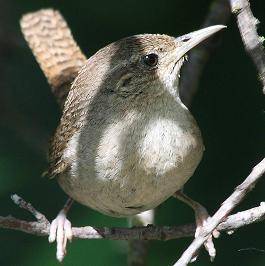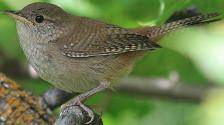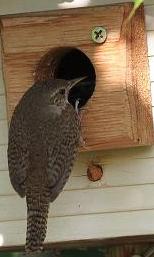House Wren
House wrens can be attracted with food, and
water. If you have trees and shrubs they may nest in
your yard. During nesting season they are loud, bold and
very active, becoming quiet and reclusive in winter.
Identification and Pictures
(Classification: Troglodytes aedon)
House wrens are about 4 1/2 to 5 1/4 inches. This is a small stubby, brownish gray
wren with darker barring on the wings, and tail.
They have pinkish legs, a light eye ring, and the beak is
curved slightly downward. They are very
energetic, often cocking their tail over their back.
Males and females are similar. There are
varying subspecies.
Photos by Keith Lee. The camera I
use is the Canon EOS 40D.
Song
The House wren's song is a quick gurgling, rising and then falling
at the end, heard during nesting season. It calls a
rapid prrr, and a harsh cheh cheh. If you get too near their
nest this pugnacious little bird will scold you with their
beak open and their body trembling.
Sound
1
Sound 2
Rrange and Habitat
House
wrens can be found from southern Canada across most of the U.S. in
summer. They winter in southern U.S., and Mexico and are resident year round in southern California, southern Mexico and South America.
They like open woods woodland edges, brushy areas, orchards
and
back yards.
Nesting and Breeding
Male wrens will build several nests for the female to choose from.
When a female arrives, he sings excitedly, with trembling
wings, and will lead her to the nests for her inspection.
She
will inspect each nest, and after she picks one she may rebuild
parts or all of it. They build a cup nest of sticks, and
grass in a cavity, and line it with feathers and other
material. The normal nest site is a natural cavity
or possibly one made by a woodpecker, but they will build in
almost anything that has a cavity. They often nest in
birdhouses, and having several around may make an area more attractive.
During nesting season they are loud, bold, and very active,
becoming quiet, and reclusive in winter.
Females will incubate
5-8 white or pinkish eggs, speckled with brown for 12 to 15
days. The young birds are fed by both parents, and will
fledge in 15 to 18 days. The birds may have more than
one brood.
Food
House wrens feed almost entirely on insects,
many which are harmful to man. They may also feed at suet
feeders.
For more on food
and feeding click here.
For more on feeders click here.
To learn about other favorite
birds click here. | 